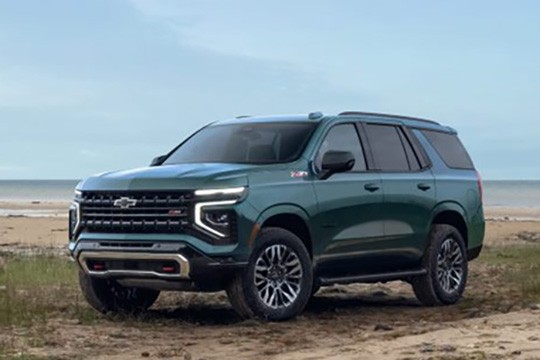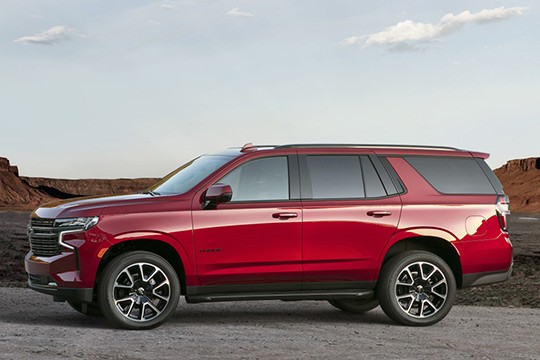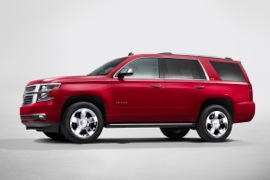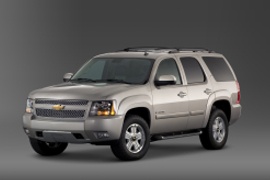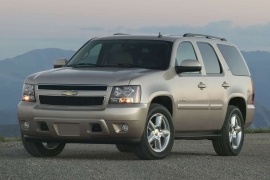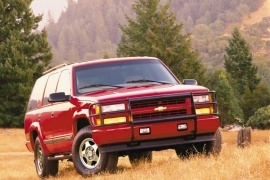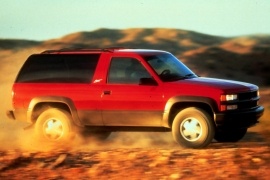CHEVROLET Tahoe Models/Series Timeline, Specifications & Photos
First production year: 1991
Engines: Diesel, Gasoline, Ethanol, Hybrid gasoline
Body style: SUV (Sports Utility Vehicle)
In late 2023, Chevrolet introduced the refreshed version of the Tahoe’s fifth generation, and the changes were so significant that the automaker could’ve called it a new generation.
While sometimes you have to have a keen eye for detail to spot the differences between a facelifted and a non-facelifted version of a car, for the 2025 Tahoe, nobody should have that problem. This long line of off-road capable, three-row family haulers and full-size SUVs became more friendly with the environment and with its customers as well. There were essential changes on the vehicle’s exterior, the interior, and under the hood that made it look like a different generation. As expected, the bow-tie brand also added more wheels and tire options.
Chevrolet offered the Tahoe in six trim levels, LS, LT, RST, Z71, Premier, and High Country, each with specific details that made them stand apart from the rest of their stablemates. Still, the most significant upgrades were for the off-road-oriented Z71 version, which was the fastest-selling version of the Tahoe. At the front, the automaker installed C-shaped LED daytime running lights that pointed inward. Some versions sported horizontal slats on the grille, while the Z71 featured an egg-crate one. It was also the version that got two red towing hooks in the apron.
From its profile, the Tahoe kept the shape and proportions of its non-facelifted version. But even here, the automaker managed to make some changes to make the SUV look better. Customers had the option of choosing darkened B-posts and black trims around the windows. There was a wide choice of nine wheels options to choose from, ranging between 18” and 24”. At the back, the automaker created new corner-mounted taillights that featured a short red upper section and a longer one at the bottom, creating a more substantial visual message when the blinkers were turned on.
Inside, it was an entirely new environment. Firstly, the dashboard was moved about an inch lower (2.5 cm) to increase the driver’s visibility. That also led to a reduction of the instrument cluster’s display from 12-inch to 11-inch, but the new screen sported an enhanced layout and was easier to read. In addition, atop the dashboard, Chevrolet installed a 17.7” touchscreen for the infotainment system, which was the widest in the industry. The Tahoe offered room for up to eight people seated on the three rows. The middle row could slide, tumble, and fold, offering an easier ingress and egress for those sitting in the rearmost positions.
Under the hood, the automaker still offered the same three engines as before, two gas-powered V8s and an inline-six turbodiesel, but these were improved. Another big news was for those who wanted the Z71 off-road version, which previously was unavailable with the torquey oil burner but it became available starting with the 2025 Tahoe model year. All versions were paired with a ten-speed automatic transmission. Besides the Z71 grade, all the others were available with either rear- or four-wheel drive systems.
Chevrolet Tahoe was first launched in 1995 and was initially called S10-Blazer, then simply Blazer and afterward rebadged as Tahoe. Now it is the best selling full-size SUV in the U.S. occupying over 25 percent of the segment, and for good reason: it is spacious, comfortable and ideal for long journeys.
The new Tahoe is powered by 3 engines. The diesel engine is 3.0-liter and has 277 hp, while the gasoline versions are 5.3-liter with 355 hp, and 6.2-liter engine with a massive 420 hp (the fuel system of gasoline versions is Turbocharged Direct Injection).
Technically, the Tahoe is almost identical to Suburban, except that Tahoe is bigger and offers more storage space. The car comes with today's required connectivity technology, Wi-Fi hotspot, Apple CarPlay, Android Auto, USB charging ports, and wireless charging. Furthermore, it comes with new technologies like new HD Surround Vision and Rear Pedestrian Alert. Cadillac Tahoe uses the rear independent air suspension, lowering the car 4 inches, to allow it to react safely and smoothly to difficult terrain.
At the rear, the tailgate, the tail lamps and the bumper were redesigned, creating a more assertive stance, while the interior provides with 40 percent more third-row legroom and 66 percent greater cargo volume behind the third row.
The first Suburban was introduced in 1935 and was the segment’s leader, thus the nameplate was kept for more than 70 years.
Just like his Suburban brother, the new Tahoe was announced in late 2013, production started in 2014 and the car was dubbed 2015.
Chevrolet decided to launch the two brothers with the same two engines: a 5.3-liter V8 and a 6.2-liter V8, both of them hooked up to the Hydra-Matic 6L80 6-speed automatic gearbox.
Most of the improvements could be noticed on the inside, where new safety features like a radar, forward collision alert, lane departure warning, lane change assist and rear cross traffic alert joined forces to keep you and your family protected. Furthermore, the new chassis was stronger and had a wider track, while the LTZ models also benefited from 3rd generation magnetic ride control that enhanced the body control using a real-time damping system.
The new functionalities available for both Tahoe and Suburban included foldable seats for the 2nd and the 3rd row offering more cargo space if necessary, grater legroom for the passengers on the 2nd row, an 8-inch touchscreen radio, six USB ports and six power outlets, a rear-seat entertainment system with a Blu-ray DVD player, keyless entry and more.
The cars were built at the GM’s Texas plant.
Chevrolet Tahoe was the leader of the full-size SUV segment in the U.S., and GM tried to keep-it in the leading position by introducing its third generation in 2007.
Chevrolet Tahoe and his siblings GMC Yukon and Cadillac Escalade were built on the same platform as the Silverado pickup truck. The refreshed lineup included heavily modified exterior and interior design and smarter powertrains, which placed the big SUV on top of its segment, above Ford Expedition or Toyota Sequoia.
The designers had to broke a sweat to make that prominent front fascia look keen with the cross-section where the Chevrolet badge was placed. For the third generation, they changed the headlights concept from the two rows of lamps into one big headlight. On the hood, the carmaker placed two power-bulges to emphasize the V8 engine under the hood.
With the proper trim level, the Tahoe's interior could have been mistaken with a premium vehicle. GM offered-it with cloth upholstery for the cheaper versions, but on the other side of the scale, the customers could find leather-wrapped seats, wood-trims on the dash and door panels, power-operated second-row seats, and a touch-screen navigation system. A folding TV screen was mounted on the rear seat passengers' ceiling to make the roads more comfortable. The last row could have been removed in the seven-seat configuration and left behind if a larger trunk was needed.
The Tahoe featured the best-in-class fuel economy due to its cylinder deactivation system. Despite the fact that a 6.0-liter V8 powered its hybrid version, the Tahoe could get a 10.2 l/100 km (23 mpg-US) on the highway.
Chevrolet introduced the third generation of the Tahoe in 2007 as a badge-engineered brother of the 2008 GMC Yukon.
With its vast experience in building large SUVs and pickups, Chevrolet built the Tahoe as a family vehicle. It was offered as a basic, six-passenger vehicle with reasonable features but without luxury trims or expensive leather upholstery. It was the large SUV that could suit most needs for six people.
The 2007 Tahoe featured a front fascia crossed from side to side by a horizontal slat, which sported the bow-tie badge in the middle. Chevrolet made the front bumper with two squared gaps on the lower side for towing or installing a bush-guard. On the sides, depending on the options, the carmaker offered a pair of an option for side steps for easier ingress and egress from the car. In the back, the big tailgate was opened in one piece for the Hybrid or with a twin system that allowed the user to open only the glass area for the rest of the range.
For the base trim levels, the Tahoe offered a black dashboard with silver plastic trims or wood for the upper trim levels. The carmaker installed a tall and wide center console between the front seats with a storage area inside. Chevrolet offered the owner the possibility to remove or fold the second and third seat rows, resulting in a cavernous storage area.
The Tahoe featured the best-in-class fuel economy due to its cylinder deactivation system. Even though a 6.0-liter V8 powered its hybrid version, the big SUV could get a 10.2 l/100 km (23 mpg-US) on the highway.
GMC tried to cover all the bases on the SUV markets, and the Tahoe was the answer for the customers who were looking for a full-size vehicle, but the Suburban was too much.
With an increased demand for SUVs and enough wide roads to drive them, American customers found the big 4x4 vehicles more valuable than the minivans. Moreover, a full-size SUV could easily tow a trailer or a camper, while a minivan was suitable just for school runs and weekly shopping. On the other hand, the minivans were mainly underpowered and didn't save that much fuel compared to an SUV. GMC introduced the Chevy Tahoe/GMC Yukon with better engines and offered them enough features to match and exceed what a minivan could provide.
At the front, the 1991 Tahoe featured a new look with two rows of lamps separated by a horizontal slat that crossed the entire front fascia. In the five-door version, the car showed wide rear doors and long windows behind them. The blackened D-pillars created an image of a wrapped-around glass area for the trunk and a floating roof design. At the back, Chevrolet offered the Tahoe with either a liftgate or a twin, side-hinged doors.
Unlike the Suburban, the five-door Tahoe offered room for five. There was no base model in the five-door version, and its CK dashboard design looked more upmarket. It was different than the one installed on the three-door Tahoe.
Power came from a standard 5.7-liter V-8 engine paired as standard to a four-speed automatic transmission. Like the Suburban, the Tahoe featured a 4x4 on-demand with a shift-on-the-fly system from 2WD to 4WD.
While Chevrolet's customers praised the K5 Blazer for its rugged ability to cross through a construction site like a hot knife through butter, the Tahoe tried to offer something more.
The Americans quickly noticed that a big SUV could handle a family's needs just as well as any other station wagon, but with an extra ability to tow a boat or clean the driveway from snow during winter. Chevrolet introduced the Tahoe in 1991 to replace the K5, and, apart from the rugged chassis, it offered a comfortable interior for at least five people, even in the three-door version. The SUV was still named K5 Blazer until the bow-tie brand decided to change its name to Tahoe after the 1995 mid-life cycle refresh and use the Blazer name for a smaller, less-rugged SUV.
At the front, the 1991 Blazer/Tahoe, which was still named Blazer, featured a new look with two rows of lamps separated by a horizontal slat that crossed the entire front fascia. In the three-door version, the Tahoe was a mix between a K5 and a comfortable family MPV. The long side window behind the B-pillar offered a 30% larger glass area than the previous K5.
Inside, Chevrolet carried over the entire dashboard from the Suburban, with a broad and squared instrument cluster that included climate control and the stereo buttons. In the back, there was room for three adults with adequate leg and headroom. The trunk was big enough for everything, and if needed, the owner could have folded the entire rear bench.
Under the hood, GM installed a 5.7-liter V8 offered in two output versions. Chevrolet also equipped the vehicle with a 6.5-liter V-8 diesel unit.
